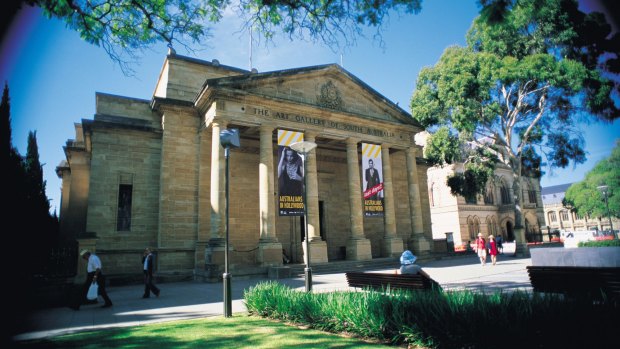By Brook Turner
To South African-born Nobel laureate J.M. Coetzee, his chosen home of Adelaide is a "paradise on earth" and "place of grace," as he said in 2006, wondering if it was necessary to die first to get there. To Salman Rushdie, speaking at the inaugural Adelaide Writers' Week 20 years earlier, the city was more simply somewhere that might kill you, "the perfect setting for a Stephen King novel or horror film".
I always think of the city as a body: human in scale, restful, but very much alive. And the Adelaide Central Market – a groaning fruit-and-veg basket encircled by delicatessens, coffee shops and superb providores – is the stomach from which it radiates.

Art Gallery of South Australia, North Terrace, Adelaide.Credit: SA Tourism Commission
North Terrace is the capital's broad civic shoulders, and the head is the collection of sandstone institutions that line it: the State Library, the South Australian Museum and the University of Adelaide. For a heart, there's the small but jam-packed Art Gallery of SA, with its choice survey of Australian art, particularly the Heidelberg School and the early modernist women artists in which South Australia abounded. There are also early purchases of work by 20th-century English artists, from the first Lucian Freud bought by a public gallery to an early Francis Bacon.
The tip of Adelaide's civic head is probably Light's Vision, the 1906 statue of the city's founder and first surveyor-general, Colonel William Light. It stands on Montefiore Hill in North Adelaide, pointing back to the gridded city he located on the plain around the Torrens River, ringed by 930 hectares of parkland. That Adelaide was founded by a man who was Eurasian, illegitimate and lived openly with his much younger mistress seems entirely suitable, given the city's brand of progressive gentility. Founded as a utopian community for free settlers, South Australia was the first Australian state to give women the vote and the first to decriminalise homosexuality.
That past is always present in Adelaide, particularly at festival time, when it transforms into the world's most avant-garde country town. The rest of the time, the city is a miracle of amenity. Everything is within easy reach, from the markets to the sprawling suburbs of bluestone houses and the beaches and wine country beyond. In half an hour you can be in the Adelaide Hills and the small, weird, German-style tourist village of Hahndorf, or the lovely, English- flavoured suburbs of Stirling and Aldgate. The Hills and McLaren Vale wine regions aren't much further, and the Barossa and Clare valleys are both easy day-trips.
Then there's the almost 4500 square kilometres of Kangaroo Island, whose beauty is gobsmacking. As is its wildness, and the variety of its wildlife: koalas, wombats, seals, sea lions, echidnas, penguins and its own subspecies of kangaroo. The beaches are pristine, the roads wide and open. It is paradise.
The old saying, "A great place to visit, but I wouldn't want to live there," is often reversed for Adelaide, which can be seen as an easy place to live, but hardly worth a visit. But it's difficult not to like a city where paradise is so close at hand, from the Central Market to the wilderness a few hours away. As Coetzee himself said of choosing a city redolent of a better past for a better future: "Adelaide strikes me as a city about the right size … I like the climate, I like the architecture. If Adelaide is slow, I like the slowness."
To read more from Good Weekend magazine, visit our page at The Sydney Morning Herald or The Age.